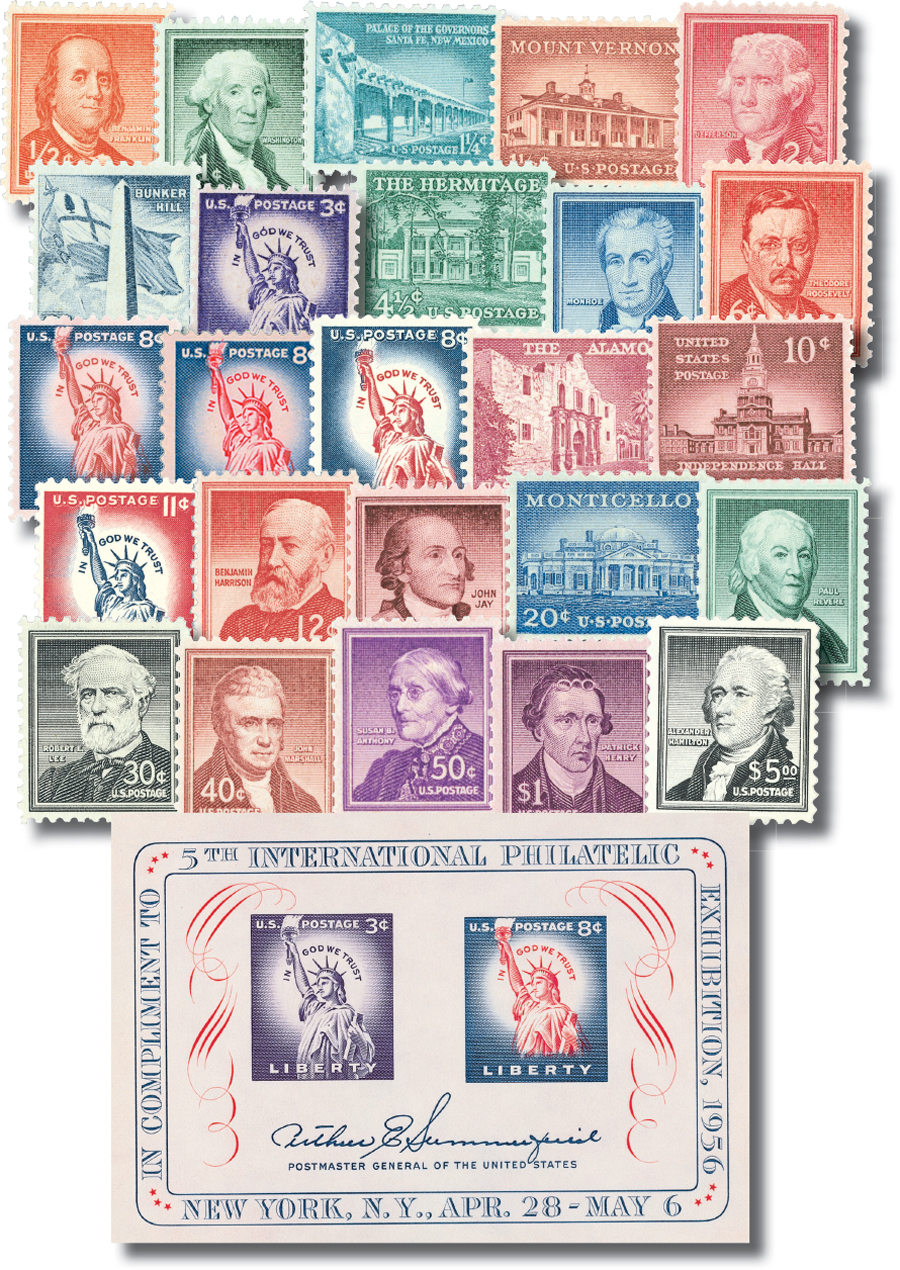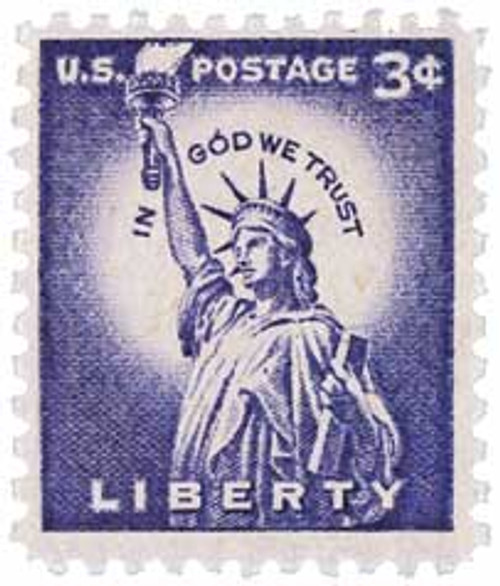
# 1030-53 - 1954-61 Liberty Series 27v 1/2c-$5
The Complete Liberty Series Can Be Yours!
Includes High-Value U.S. #1053
Issued between 1954 and 1961, the Liberty Series is filled with the leaders and landmarks of 200 years of America’s history. It honors the guardians of freedom – Washington, Jefferson, Franklin, Patrick Henry and others who led the fight for independence, shaped the new government, and guided it through war and peace as well as through our westward expansion. Historic landmarks include Independence Hall, Bunker Hill Monument, the Alamo and the Statue of Liberty, represented by four stamps in the series.
Set includes Scott #1053 (Alexander Hamilton) – the key stamp in the Liberty Series. Due to its high face value it was used primarily on registered mail, typically to mail money between small post offices and Federal Reserve Banks. It is relatively scarce in mint condition.
The Liberty Series is an essential part of any serious U.S. collection – which means it belongs in your collection. Get these 28 stamps and save off Mystic’s regular retail price.
First Stamp Issued In Liberty Series

On April 9, 1954, the USPS introduced a new set of stamps, the Liberty Series, with the issue of an 8¢ red, white, and blue Statue of Liberty stamp.
The Liberty Series was first announced in late 1953, as a replacement for the popular Presidential Series (also known as the Prexies), which had been in use for 15 years. The new series took its name from the first stamp to be issued, picturing the Statue of Liberty.

The Liberty Series would mark a significant departure from the Prexies. It would include “warm portraits” rather than “hard profile busts.” It would also make use of the work of a variety of artists and photographers. Additionally, presidents would only make up a small portion of the featured subjects (7 out of 25 denominations).
Plus, the Liberty Series was only planned to utilize 18 different denominations, whereas the Prexies had 32. It turned out that many of the Presidential denominations were rarely used. So the new series would ensure that no more than two stamps would be needed to pay 60¢ in postage and no more than three for up to $1.60.
The first stamp in the Liberty Series was issued on April 9, 1954. President Dwight D. Eisenhower presided over a special televised ceremony debuting the stamp, which was the first to include the motto, “In God We Trust.”

The Liberty Series was issued from 1954-61. It included definitive stamps with denominations ranging from 1/2¢ to $5. It would be the last 1/2¢ definitive stamp issued by the US. The patriotic set of stamps honored guardians of freedom throughout US history.

Eighteenth century America was represented by Revolutionary War heroes and statesmen such as Washington, Jefferson, Franklin, Hamilton, Henry, Jay, and Revere. Leaders of the 19th century including Monroe, Lincoln, Lee, Harrison, and Susan B. Anthony made an appearance. Teddy Roosevelt, Woodrow Wilson, and General Pershing represented the 20th century. The Liberty Series also featured famous locations important to America’s democratic history, such as Bunker Hill, Independence Hall, and the Alamo.

US #1053 (Alexander Hamilton) is the key stamp in the series. Due to its high face value it was used primarily on registered mail, typically to mail money between small post offices and Federal Reserve Banks. It is relatively scarce in mint condition.
These stamps were also part of a Bureau of Engraving and Printing experiment that began in 1954. In previous “wet” printings, the paper had a moisture content of 15 to 35 percent. In the experimental “dry” printings, the paper had a moisture content of 5 to 10 percent. This process required stiffer, thicker paper, special inks, and greater pressure to force the paper through the plates.
Stamps produced by dry printing can be distinguished by whiter paper and higher surface sheen. The stamps feel thicker and the designs are more pronounced than on wet printings. So the dry printing experiment was a success, and all US postage stamps have been printed by this method since the late 1950s.
The Complete Liberty Series Can Be Yours!
Includes High-Value U.S. #1053
Issued between 1954 and 1961, the Liberty Series is filled with the leaders and landmarks of 200 years of America’s history. It honors the guardians of freedom – Washington, Jefferson, Franklin, Patrick Henry and others who led the fight for independence, shaped the new government, and guided it through war and peace as well as through our westward expansion. Historic landmarks include Independence Hall, Bunker Hill Monument, the Alamo and the Statue of Liberty, represented by four stamps in the series.
Set includes Scott #1053 (Alexander Hamilton) – the key stamp in the Liberty Series. Due to its high face value it was used primarily on registered mail, typically to mail money between small post offices and Federal Reserve Banks. It is relatively scarce in mint condition.
The Liberty Series is an essential part of any serious U.S. collection – which means it belongs in your collection. Get these 28 stamps and save off Mystic’s regular retail price.
First Stamp Issued In Liberty Series

On April 9, 1954, the USPS introduced a new set of stamps, the Liberty Series, with the issue of an 8¢ red, white, and blue Statue of Liberty stamp.
The Liberty Series was first announced in late 1953, as a replacement for the popular Presidential Series (also known as the Prexies), which had been in use for 15 years. The new series took its name from the first stamp to be issued, picturing the Statue of Liberty.

The Liberty Series would mark a significant departure from the Prexies. It would include “warm portraits” rather than “hard profile busts.” It would also make use of the work of a variety of artists and photographers. Additionally, presidents would only make up a small portion of the featured subjects (7 out of 25 denominations).
Plus, the Liberty Series was only planned to utilize 18 different denominations, whereas the Prexies had 32. It turned out that many of the Presidential denominations were rarely used. So the new series would ensure that no more than two stamps would be needed to pay 60¢ in postage and no more than three for up to $1.60.
The first stamp in the Liberty Series was issued on April 9, 1954. President Dwight D. Eisenhower presided over a special televised ceremony debuting the stamp, which was the first to include the motto, “In God We Trust.”

The Liberty Series was issued from 1954-61. It included definitive stamps with denominations ranging from 1/2¢ to $5. It would be the last 1/2¢ definitive stamp issued by the US. The patriotic set of stamps honored guardians of freedom throughout US history.

Eighteenth century America was represented by Revolutionary War heroes and statesmen such as Washington, Jefferson, Franklin, Hamilton, Henry, Jay, and Revere. Leaders of the 19th century including Monroe, Lincoln, Lee, Harrison, and Susan B. Anthony made an appearance. Teddy Roosevelt, Woodrow Wilson, and General Pershing represented the 20th century. The Liberty Series also featured famous locations important to America’s democratic history, such as Bunker Hill, Independence Hall, and the Alamo.

US #1053 (Alexander Hamilton) is the key stamp in the series. Due to its high face value it was used primarily on registered mail, typically to mail money between small post offices and Federal Reserve Banks. It is relatively scarce in mint condition.
These stamps were also part of a Bureau of Engraving and Printing experiment that began in 1954. In previous “wet” printings, the paper had a moisture content of 15 to 35 percent. In the experimental “dry” printings, the paper had a moisture content of 5 to 10 percent. This process required stiffer, thicker paper, special inks, and greater pressure to force the paper through the plates.
Stamps produced by dry printing can be distinguished by whiter paper and higher surface sheen. The stamps feel thicker and the designs are more pronounced than on wet printings. So the dry printing experiment was a success, and all US postage stamps have been printed by this method since the late 1950s.
















